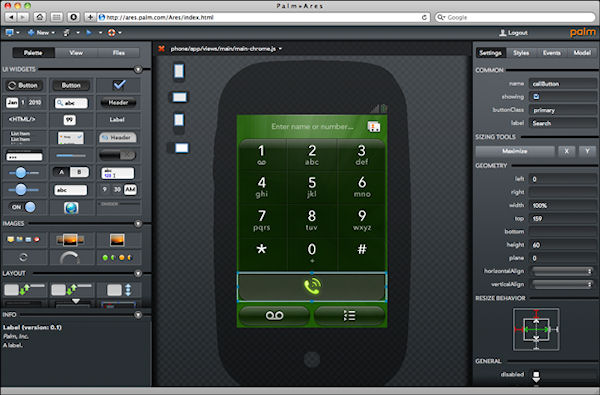By Scott M. Fulton, III, Betanews

 Today, Intel CEO Paul Otellini is absolutely not expected to come to the keynote stage at CES 2010 empty-handed. Already this morning, the company launched its GPU-on-a-die "Westmere" architecture 32 nm CPUs, with graphics processors sandwiched right in. Windows 7 computers from Toshiba and others with Westmere processors went on sale nationwide this morning.
Today, Intel CEO Paul Otellini is absolutely not expected to come to the keynote stage at CES 2010 empty-handed. Already this morning, the company launched its GPU-on-a-die "Westmere" architecture 32 nm CPUs, with graphics processors sandwiched right in. Windows 7 computers from Toshiba and others with Westmere processors went on sale nationwide this morning.
And we're also likely to hear a lot about Intel's next generation Atom processor and platform, and see some of the small computers and devices that utilize it. Atom's greatest competition in recent days comes not from AMD but from Qualcomm, whose Snapdragon platform powers Lenovo's newest Linux-based "smartbook," the Skylight.
5:38pm PT: End of keynote, as "Magic Mirror" shouts back at folks as they get up to leave.
5:37pm PT: "Our goal is to have our architecture provide the brains for anything with a power source. Our job is to invent the future."
5:37pm PT: Otellini: "What you saw today wasn't science fiction; it's science." Video of a robot that can plug itself into an electrical socket. It has to find a socket first, and it's slow. "Okay...Moore's Law isn't there yet," Otellini admits.
5:35pm PT: "Magic Mirror" from Shrek makes a guest appearance on stage.
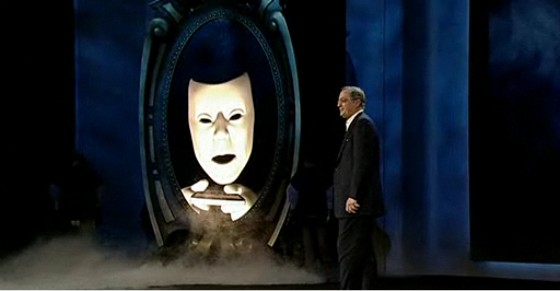
Mirror tells Otellini the truth: That the future doesn't exist, but that our heroes were really playing around Intel Labs, where the future does exist.
5:32pm PT: Demo of digital retail signage using bright LCD screens, content draws in users from afar. On the left, holographic glass touch-screen display with interactive view of the entire store. On Core i7 processors.
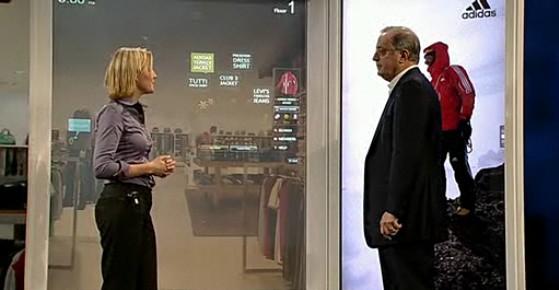
5:27pm PT: In future 2075 in Canada, curling brooms are connected to all other known devices, including communications.

5:24pm PT: New LG Moblin-based, Moorestown-platform smartphone, available in 2H 2010, can play 720p HD video -- such as movie trailers, running simultaneously with other apps.

5:21pm PT: Now shifting topics to smartphones, Intel's Moorestown platform based on Atom. First 4G platform is WiMAX, now Vegas is "lit up" citywide with Clear network.
5:18pm PT: Demo of Dell's version of AppUp Center on Moblin. App that comes up is "Frame," a combo IM and VoIP app.

Stores are not identical on all platforms; vendors can customize their storefronts to suit their purposes and tastes.
5:16pm PT: Otellini: Atom launched 18 months ago. Went on to spawn a new PC category, the netbook. 40 million netbooks shipped in the last 18 months. (Notable that Intel has no trouble calling it "netbook" now, downgrading its old MID concept.)
Next generation Atom has 20% lower power than previous generation. Thinner netbooks with integrated graphics, networking capability, on the chip. New wave of software applications.
Atom Developers' Program -- a way for developers to adapt old applications to take advantage of the netbook explosion. Consumers will be given beta to first storefront of AppUp Center, one-stop shop for users to find netbook apps for Windows and Linux.
5:14pm PT: In the future, according to Intel's staff members (circa 2050), clothes will be able to scout the Internet for future data on anything you happen to be looking at...including your date.
5:11pm PT: Now showing a wall-based app platform for the digital home, kind of a bulletin board system with apps for the home. Leave messages for kids, check on energy usage, plan to change temperature after leaving, double-check energy consumption.

5:07pm PT: Otellini wishing he could see the bowl game (the BCS championship has just started).
5:06pm PT: Demo service is made by UK carrier Orange. Can bring up already seen bowl games. "Talk about a box that's so smart, it actually time-travels -- kinda nice."

5:05pm PT: IPTV STB using Intel "Sodaville" components shows live stream previews while the main video is still up. Several other channels are shown in miniature and demi-3D.
5:04pm PT: Now demo-ing a "Futuristic Intel Digital Crib" home of the future...hopefully without the bacon.
5:03pm PT: "I believe the world of entertainment will be driven by Moore's Law."
Security, personal finance, conferencing, health -- all these [apps] are changing the way we live.
Technology has the potential not only to save money but save the environment. Demand for power will grow 19% in the next decade, while capacity will only grow 6%. Technology could reduce costs by 31%.
5:02pm PT: New Core i3, i5, and i7 processors announced this morning. Core i5 and Core i7 contain "Turbo Boost," for as-needed overclocking. Independent overclocker ran a new i7 at 7 GHz. (Don't know whether it melted down.)
Integrated graphics can run World of Warcraft without the need for a discrete graphics card. Technology that was in studios a few short years ago, is now in notebooks.
But this technology is moving into TVs -- TVs are becoming "smart TVs." Show content from any source at any time. For navigation, there will be advanced search and gesture recognition. Will bring on a new class of applications that will complement and enhance the TV experience. "But at the end of the day, we have to keep it simple." Develop new UIs, more processing power to handle all that content. Intel SoCs being built around Atom cores for smart TVs, with circuitry that video industry needs for encoding and display.
4:59pm PT: "We see Wi-Fi moving into everything -- cameras, TVs, appliances."
Wi-Di concept will stream devices to Core i5 laptops, and directly to HDTVs, with Intel wireless display technology built in.
4:58pm PT: Otellini: "Content is only part of the equation. Increasingly, we'll need new ways to share and use that content."
SuperSpeed USB, or USB 3.0, is 10x the performance of USB 2.0. Also working on even faster technology, Light Peak. Capable of 10 Gbps transfer rate, or the complete download of a Blu-ray movie in 30 seconds. Could replace all video cables, Sony and Nokia have already announced support. PCs will have this technology in 2010.
4:56pm PT: The crowd's now watching a sneak peek of DreamWorks' "How to Train Your Dragon" in 3D.
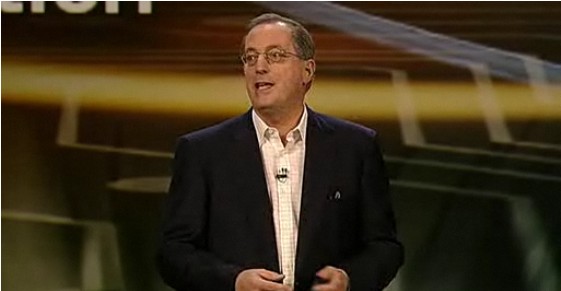
Otellini begins by remarking about Intel being a company based on Moore's Law, where a company doubles the number of processors in a chip every 24 months. (Note it's no longer 18 months.) As part of the company's gag video, Otellini asked two members of his staff to don time-machine suits and travel to the future, see what everyday folks are using, and report back home.

In one of their reports home, the duo report from the year 2025, where they've arrived at the "Booker" home, a place made more livable through the miracle of robotics. There, whatever a person happens to be thinking of, the robot goes and does. As an example, a staff member "thinks" of something (very, very deeply), and suddenly, the robot emerges with a plate of bacon.
"I'm glad to learn that bacon is a part of our future," Otellini told the crowd, quite deadpan.
Presently the crowd is donning 3D glasses, and watched a video from DreamWorks Animation (content was blacked out on the live stream). With glasses still donned, Intel staff are now showing how an everyday person can produce a 3D video using an Alienware computer.
4:36pm PT: "Paul was talking with me about, this is the time to invest in the future," and get good people in your company. Compared against other companies that succumbed to some extent to 2009's recession.
4:35pm PT: Keynote begins as always with opening remarks by CEA Pres./CEO Gary Shapiro. "The kind of innovation that makes our lives more exciting and more fulfilling, and spans every sector of our lives," is how Shapiro defines Intel's role. Reminds us Otellini serves on the board of directors of Google.
Copyright Betanews, Inc. 2010













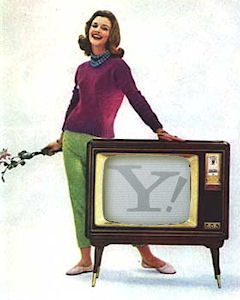 For five years, Yahoo has been eying the TV screen as a potential platform. Now, after securing partnerships with all of the top TV makers and IP-based content providers, Yahoo has made its Widget Developer Kit publicly available.
For five years, Yahoo has been eying the TV screen as a potential platform. Now, after securing partnerships with all of the top TV makers and IP-based content providers, Yahoo has made its Widget Developer Kit publicly available.









 The phrase, "There's an app for that," has helped the Apple iPhone become one of the most popular smart phones in the world by making it easier for consumers to download applications, widgets, and gadgets. "The number of apps users can download, free or for a fee, has become a major selling point for mobile devices,"
The phrase, "There's an app for that," has helped the Apple iPhone become one of the most popular smart phones in the world by making it easier for consumers to download applications, widgets, and gadgets. "The number of apps users can download, free or for a fee, has become a major selling point for mobile devices," 

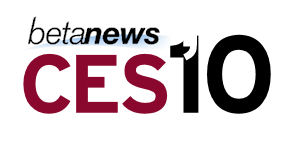 If you're a 2.0 GHz quad-core notebook PC running Windows 7, the place you do not want to be showing yourself right now is the Consumer Electronics Show. Like any other year, CES is about platform evolution, sometimes revolution. Where the most concepts evolve is where the action revolves, and this year it's around the growing confidence that manufacturers have finally found a small form factor they can invest in and make money on.
Netbooks, throughout their brief history, have been cheap, rubber-stamp PCs. That won't be the case for very long, as both Intel and Qualcomm now have argued strong cases in favor of multicore connectivity devices with limited, though functional, computing power for the consumer. There will be strong competition in this field, with Intel's Atom head-to-head in the consumer space against Qualcomm's Snapdragon, and with OEMs everywhere testing both brands and favoring neither over the other at this early stage.
If you're a 2.0 GHz quad-core notebook PC running Windows 7, the place you do not want to be showing yourself right now is the Consumer Electronics Show. Like any other year, CES is about platform evolution, sometimes revolution. Where the most concepts evolve is where the action revolves, and this year it's around the growing confidence that manufacturers have finally found a small form factor they can invest in and make money on.
Netbooks, throughout their brief history, have been cheap, rubber-stamp PCs. That won't be the case for very long, as both Intel and Qualcomm now have argued strong cases in favor of multicore connectivity devices with limited, though functional, computing power for the consumer. There will be strong competition in this field, with Intel's Atom head-to-head in the consumer space against Qualcomm's Snapdragon, and with OEMs everywhere testing both brands and favoring neither over the other at this early stage.
 So what did you think of the Windows Mobile 7 sneak preview that Microsoft CEO Steve Ballmer slipped into his CES keynote last night?
So what did you think of the Windows Mobile 7 sneak preview that Microsoft CEO Steve Ballmer slipped into his CES keynote last night?


 Today, Intel CEO Paul Otellini is absolutely not expected to come to the keynote stage at CES 2010 empty-handed. Already this morning, the company launched its
Today, Intel CEO Paul Otellini is absolutely not expected to come to the keynote stage at CES 2010 empty-handed. Already this morning, the company launched its 







